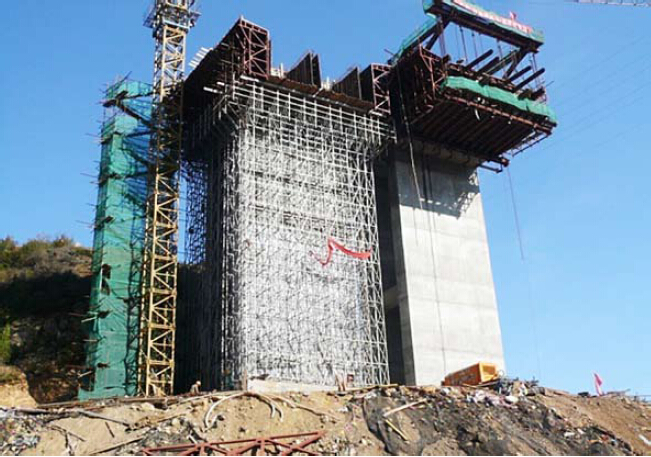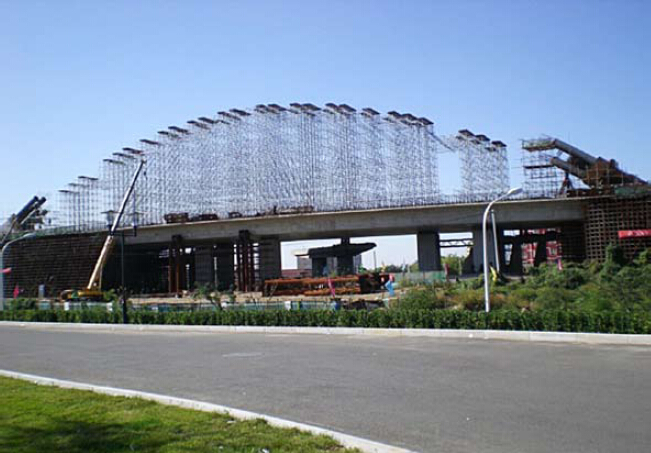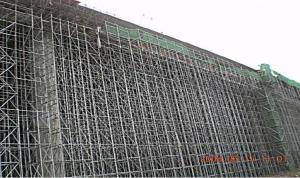Tower scaffolding for formwork and scaffolding systems
- Loading Port:
- Tianjin
- Payment Terms:
- TT OR LC
- Min Order Qty:
- 50 m²
- Supply Capability:
- 1000 m²/month
OKorder Service Pledge
Quality Product, Order Online Tracking, Timely Delivery
OKorder Financial Service
Credit Rating, Credit Services, Credit Purchasing
You Might Also Like
Tower Scaffolding
Shoring tower is an effective supporting system. It is easy to assemble and dismantlement, and
has excellent stability and bearing capacity. It has been widely used in the construction of industry
& residential buildings , bridges, tunnels and dam project, etc.
Characteristics:
◆ High degree of standardization.
◆ Easy storage and transportation


- Q:PVC building template introduction
- PVC building template is also called wood plastic formwork, plastic formwork, plastic formwork.PVC building template is an energy-saving and environment-friendly products, after the wooden template, composite steel formwork, bamboo plywood, all steel template and a new type of product. Can completely replace the steel formwork, formwork, timber, traditional energy saving and environmental protection, low cost amortization.
- Q:What are the different types of connectors used with steel formwork?
- There are several types of connectors that can be used with steel formwork to ensure stability and proper alignment. These connectors are designed to securely join the formwork components together and provide a reliable connection. 1. Wedge connectors: These are commonly used connectors that consist of a wedge-shaped piece that fits into a slot or hole in the formwork. The wedge is then tightened, which creates a strong and secure connection. Wedge connectors are easy to install and remove, making them a popular choice for steel formwork systems. 2. Pin connectors: Pin connectors are typically used to connect two formwork panels together. They consist of a pin that is inserted through holes in the formwork panels and secured with a locking mechanism. Pin connectors are simple and effective, providing a stable connection between the panels. 3. Bolt connectors: Bolt connectors are used when a more heavy-duty and permanent connection is required. These connectors consist of bolts that are inserted through pre-drilled holes in the formwork components and then tightened with nuts. Bolt connectors offer a high level of strength and stability, making them suitable for larger formwork systems or when dealing with higher loads. 4. Clamp connectors: Clamp connectors are used to join formwork components together by clamping them with a fastening mechanism. These connectors typically consist of metal plates or brackets that are tightened around the formwork components, ensuring a secure connection. Clamp connectors are versatile and can be used in various formwork applications. 5. Magnetic connectors: Magnetic connectors are a newer type of connector that utilize magnets to join formwork components together. These connectors are typically made of steel and contain strong magnets that attract to each other, creating a secure connection. Magnetic connectors are easy to install and remove, and they eliminate the need for additional tools or fasteners. Overall, the choice of connector used with steel formwork depends on the specific requirements of the project, including the size and complexity of the formwork system, load-bearing capacity, and desired ease of installation and removal. It is important to select connectors that are compatible with the formwork components and provide the necessary strength and stability for the construction process.
- Q:How does steel formwork affect the overall project budget?
- The overall project budget can be significantly impacted by steel formwork. Although steel formwork may be more expensive initially compared to other types of formwork like timber or plywood, it provides several advantages that can ultimately result in cost savings. Durability is one of the main benefits of steel formwork. Steel is a strong and long-lasting material that can withstand multiple uses without wearing down. This means that steel formwork can be reused for many projects, reducing the need for frequent replacements and lowering long-term costs. In addition, steel formwork allows for faster construction times. Its strength and stability enable contractors to pour concrete more quickly, reducing labor costs and streamlining the construction process. Moreover, steel formwork can be easily put together and taken apart, resulting in shorter intervals between projects. Steel formwork also ensures high-quality concrete structures with precision and consistency. This can minimize the need for rework and corrections, thereby reducing costs associated with fixing errors or imperfections. Furthermore, steel formwork offers design flexibility. It can be customized to fit different shapes and sizes, providing greater architectural freedom and creativity. This versatility can lead to cost savings by eliminating the need for expensive and complex modifications to the formwork system. Lastly, steel formwork is resistant to moisture and weather conditions. Unlike timber or plywood, steel does not warp or deteriorate when exposed to moisture, which can save costs by avoiding replacements or repairs due to water damage. To summarize, although steel formwork may be initially more expensive, its durability, reusability, speed, precision, flexibility, and resistance to environmental factors can result in overall cost savings throughout the project. By considering the long-term benefits and efficiencies offered by steel formwork, project budgets can be effectively managed and optimized.
- Q:How does steel formwork affect the overall constructability of a structure?
- Steel formwork can have a significant impact on the overall constructability of a structure. One of the major advantages of using steel formwork is its durability and strength. Steel is known for its high load-bearing capacity, which allows it to withstand the pressure exerted by fresh concrete during the pouring and curing process. This durability ensures that the formwork remains intact and stable, reducing the risk of collapse or deformation during construction. Another advantage of steel formwork is its reusability. Unlike traditional formwork materials such as timber, steel can be used multiple times without losing its structural integrity. This not only saves costs associated with purchasing new formwork for each construction project but also reduces waste and promotes sustainability. Steel formwork also offers flexibility and versatility in terms of design and construction requirements. It can be easily fabricated into various shapes and sizes, enabling the construction of complex structures with intricate architectural details. Steel formwork can be customized to fit specific project needs, allowing for efficient and precise construction. Additionally, steel formwork provides a smooth and uniform finish to the concrete surface. This eliminates the need for additional finishing work, such as plastering or sanding, reducing construction time and costs. The smooth finish also enhances the aesthetic appeal of the structure, making it suitable for architectural projects where visual appeal is essential. Furthermore, steel formwork is known for its excellent dimensional stability. It resists warping, shrinking, or expanding due to moisture or temperature changes, ensuring accurate and consistent dimensions throughout the construction process. This dimensional stability contributes to the overall quality and precision of the structure. In summary, steel formwork positively affects the overall constructability of a structure by providing durability, reusability, flexibility, smooth finish, and dimensional stability. These advantages not only enhance the efficiency and speed of construction but also ensure the structural integrity and aesthetic appeal of the final product.
- Q:Can steel formwork be used for both interior and exterior concrete finishes?
- Yes, steel formwork can be used for both interior and exterior concrete finishes. Steel formwork is known for its strength and durability, making it suitable for a variety of applications. Whether it is for interior walls, columns, or exterior slabs, steel formwork provides a smooth and consistent surface for the concrete to be poured into. Additionally, steel formwork can be easily customized and adjusted to meet specific project requirements, making it a versatile choice for both interior and exterior concrete finishes.
- Q:Can steel formwork be used for projects with limited formwork stripping time?
- Yes, steel formwork can be used for projects with limited formwork stripping time. Steel formwork is known for its durability and strength, making it suitable for various construction projects. Unlike traditional formwork materials such as wood or plywood, steel formwork can withstand higher pressures and loadings, allowing for faster construction cycles. Steel formwork is often used in high-rise buildings, bridges, and infrastructure projects where time is of the essence. Its rigid structure allows for quick assembly and disassembly, minimizing the time required for formwork stripping. Additionally, steel formwork can be reused multiple times, further reducing construction time and costs. Furthermore, steel formwork offers precise dimensional control, ensuring accurate and consistent results. This is particularly important for projects with limited formwork stripping time, as any errors or inconsistencies in the formwork can lead to delays and additional work. However, it is important to note that steel formwork may require skilled labor and specialized equipment for installation and removal. Therefore, proper planning and coordination are crucial to ensure efficient and safe use of steel formwork for projects with limited formwork stripping time.
- Q:How does steel formwork affect the structural integrity of a building?
- Steel formwork is a construction technique that uses steel molds to create the desired shape and structure of concrete elements in a building. It plays a crucial role in the construction process and affects the structural integrity of a building in several ways. Firstly, steel formwork provides a strong and rigid support system for the wet concrete during the pouring and setting process. Its robustness ensures that the concrete remains in the desired shape and prevents any deformation or collapse. This is particularly important for structural elements such as beams, columns, and walls, as it ensures their proper alignment and stability. Additionally, steel formwork allows for precise and accurate construction. The molds can be fabricated with great precision, resulting in accurate dimensions and shapes for the concrete elements. This precision is essential for maintaining the structural integrity of the building, as any slight deviation or misalignment can compromise the overall strength and stability of the structure. Moreover, steel formwork provides a smooth surface finish to the concrete. This smoothness is not only aesthetically pleasing but also contributes to the structural integrity of the building. A smooth surface reduces the likelihood of cracks, voids, or air pockets in the concrete, which can weaken its strength and durability. Furthermore, steel formwork offers durability and reusability. Unlike other types of formwork, such as wood or plastic, steel formwork can withstand multiple uses without losing its structural integrity. This reusability not only saves construction costs but also ensures consistency in the quality of the concrete elements throughout the building. Lastly, steel formwork enhances the overall structural stability of the building. The use of steel molds provides a rigid framework that distributes the loads evenly and efficiently. This distribution of loads minimizes the risk of localized stress concentrations, thereby improving the structural integrity of the building and increasing its overall resistance to external forces such as wind, earthquakes, or heavy loads. In conclusion, steel formwork significantly impacts the structural integrity of a building in a positive way. It provides a strong support system, ensures precision and accuracy, offers a smooth surface finish, provides durability and reusability, and enhances overall structural stability. All these factors contribute to the strength, stability, and longevity of the building, making steel formwork an essential component in modern construction practices.
- Q:How does steel formwork contribute to the overall durability of a structure?
- Steel formwork contributes to the overall durability of a structure by providing a strong and rigid framework during the concrete pouring process. It ensures accurate and precise shaping of the concrete, resulting in a solid and uniform structure. Steel formwork is highly resistant to warping, bending, and cracking, making it more durable than other types of formwork materials. Its strength and durability allow for multiple reuse, reducing construction costs and minimizing waste. Additionally, steel formwork provides excellent support for the concrete as it cures, preventing any deformation or collapse. Overall, steel formwork plays a crucial role in enhancing the longevity and robustness of a structure.
- Q:Can steel formwork be used for hospital construction projects?
- Yes, steel formwork can be used for hospital construction projects. Steel formwork is a versatile and durable construction material that offers several advantages for hospital projects. It provides excellent strength and stability, which is crucial for ensuring the safety and integrity of the building. Steel formwork also allows for efficient and precise construction, as it can be easily assembled and disassembled, and its modular nature allows for flexibility in design and layout changes. Additionally, steel formwork has a smooth surface finish, which is important for maintaining a hygienic environment in a hospital setting. It is also resistant to moisture and chemicals, making it suitable for areas that require frequent cleaning and sterilization. Overall, steel formwork is a reliable and suitable choice for hospital construction projects.
- Q:What are the standard dimensions of steel formwork panels?
- The standard dimensions of steel formwork panels can vary depending on the specific requirements and preferences of the construction project. However, there are common standard dimensions that are widely used in the industry. Typically, steel formwork panels are available in standard lengths ranging from 1 to 3 meters (3 to 10 feet), with a standard width of around 0.6 meters (2 feet). The thickness of the steel panels can also vary, but it is commonly around 12 to 16 millimeters (0.5 to 0.6 inches). These dimensions are designed to provide a strong and sturdy formwork system that can withstand the pressures and forces exerted during concrete pouring and curing. Additionally, these dimensions allow for easy handling and transportation of the formwork panels on the construction site. It is important to note that the dimensions of steel formwork panels can be customized to suit specific project requirements. This flexibility allows for the creation of unique formwork systems that can accommodate various shapes and sizes of concrete structures.
1. Manufacturer Overview |
|
|---|---|
| Location | |
| Year Established | |
| Annual Output Value | |
| Main Markets | |
| Company Certifications | |
2. Manufacturer Certificates |
|
|---|---|
| a) Certification Name | |
| Range | |
| Reference | |
| Validity Period | |
3. Manufacturer Capability |
|
|---|---|
| a)Trade Capacity | |
| Nearest Port | |
| Export Percentage | |
| No.of Employees in Trade Department | |
| Language Spoken: | |
| b)Factory Information | |
| Factory Size: | |
| No. of Production Lines | |
| Contract Manufacturing | |
| Product Price Range | |
Send your message to us
Tower scaffolding for formwork and scaffolding systems
- Loading Port:
- Tianjin
- Payment Terms:
- TT OR LC
- Min Order Qty:
- 50 m²
- Supply Capability:
- 1000 m²/month
OKorder Service Pledge
Quality Product, Order Online Tracking, Timely Delivery
OKorder Financial Service
Credit Rating, Credit Services, Credit Purchasing
Similar products
New products
Hot products
Hot Searches
Related keywords























